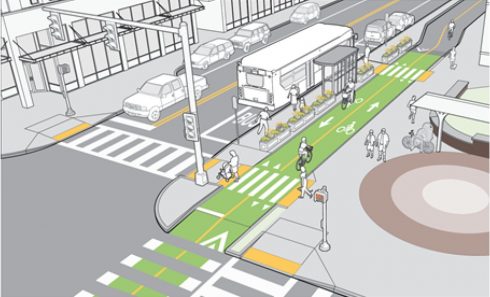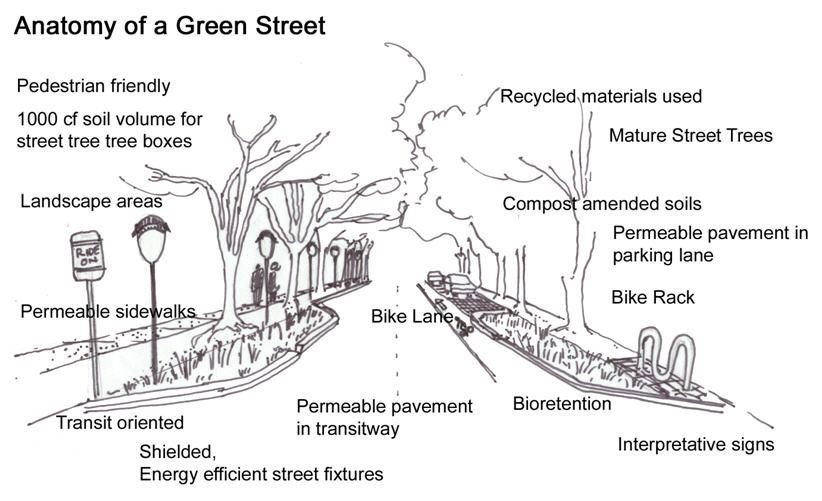
You’ve Heard of Complete Streets. What are Green Streets?
- July 27, 2023
- Transportation
For several years, SWRPC has been a leader in advancing the implementation of “Complete Streets” – streets that accommodate not just motor vehicles, but also pedestrians and bicyclists where appropriate. Out of 14 NH municipalities known to have adopted a complete streets policy, 10 of them are in the Monadnock Region and 9 of those were assisted by SWRPC. As part of SWRPC’s efforts to build staff capacity and stay informed on the latest complete streets best practices, we’ve recently devoted time to understand a related concept, “Green Streets.”

Green streets refers to strategies that can help make communities more resilient to extreme weather and other climate effects. Specifically, green streets aim to more adequately manage storm water by reducing the amount of impermeable surface, such as asphalt, that is present in a given area. Strategies to accomplish this goal can look very different depending on the climate, population density, and design of the given space, but are inherently connected with complete streets design.
As the National Association of City Transportation Officials (NACTO) states, “a flooded street is not a complete street.” During a flooding event, the first populations to be impacted will likely be those who are on foot, on bike, or those accessing public transportation. Therefore, it is critical that streets which are accessible to various modes of transportation manage stormwater effectively. Green streets aim to accomplish this goal while also improving the aesthetics and livability of the space, such as the addition of trees that can provide shade, or planters with native flowers.

The implementation of green streets principles could help mitigate the impacts of climate change while protecting our natural resources and infrastructure investments. On a regional level, green streets can help southwest New Hampshire adapt to increasingly volatile weather. Climate change is predicted to increase the frequency of extreme precipitation events, which can lead to increased runoff entering the environment. This runoff can include road salt, sediments, and other pollutants, all of which can seriously damage aquatic ecosystems. Extreme precipitation events can also lead to flooding and have detrimental impacts on infrastructure, such as the road washouts seen from the July 2023 flooding in numerous local communities, including Alstead, Harrisville, Swanzey, and Winchester.

The Monadnock Region is primarily rural but is punctuated by pockets of high population density. Resultantly, to adequately address such a varied region, a variety of different approaches from the Green Streets “toolbox” would need to be used. In more rural regions, there tends to be a lesser amount of developed surface, which may mean there is less runoff to manage. Despite this, rural regions are unlikely to have any extensive storm water infrastructure in place, such as storm drains or gutters, and roads may be susceptible to excessive stormwater runoff. Therefore, when there are heavy precipitation events, flooding may still occur, and runoff will likely enter the environment directly and with little filtration. To compound this concern, rural areas tend to be in closer proximity to important natural resources, such as lakes and rivers, and wetlands. Unfiltered runoff entering these features can carry numerous pollutants which can impact the health of our natural resources. Therefore, in areas which appear to be particularly sensitive, it may be pertinent to install facilities such as rock gardens, drainage swales, or other drainage methods.

In areas with greater population density and more less permeable surface area, green streets principles can be integrated into street design in numerous ways. Perhaps the clearest way to consider their installation is during a planned improvement to a street. Given a hypothetical scenario where a town is planning to implement curb extensions to make pedestrian crossings safer on a busy commercial street, the creation of planters within the structure to help manage stormwater could be considered.
In another hypothetical scenario, a town that wishes to reduce driver speed on a busy residential avenue could install distinct-colored permeable pavers instead of asphalt for the available on-street parking, an approach which has been shown to help calm traffic, as well as reduce runoff.

Green streets principles represent a collection of strategies and tools which may be used to help make the Monadnock Region more resilient to future flooding events and improve access for all users of a street. If your community is interested in learning more about green streets, contact Jason Cooper of SWRPC staff ([email protected]).



